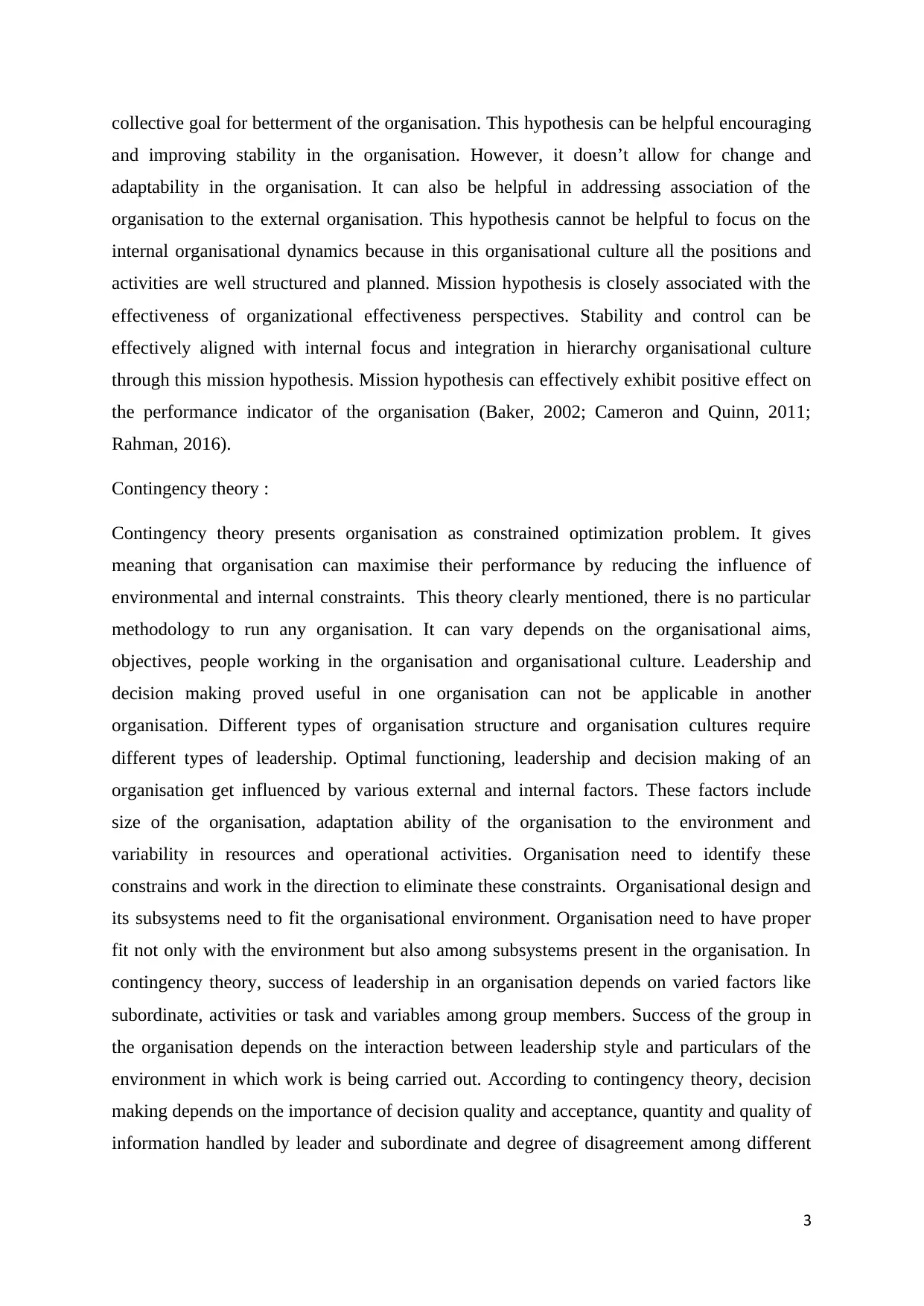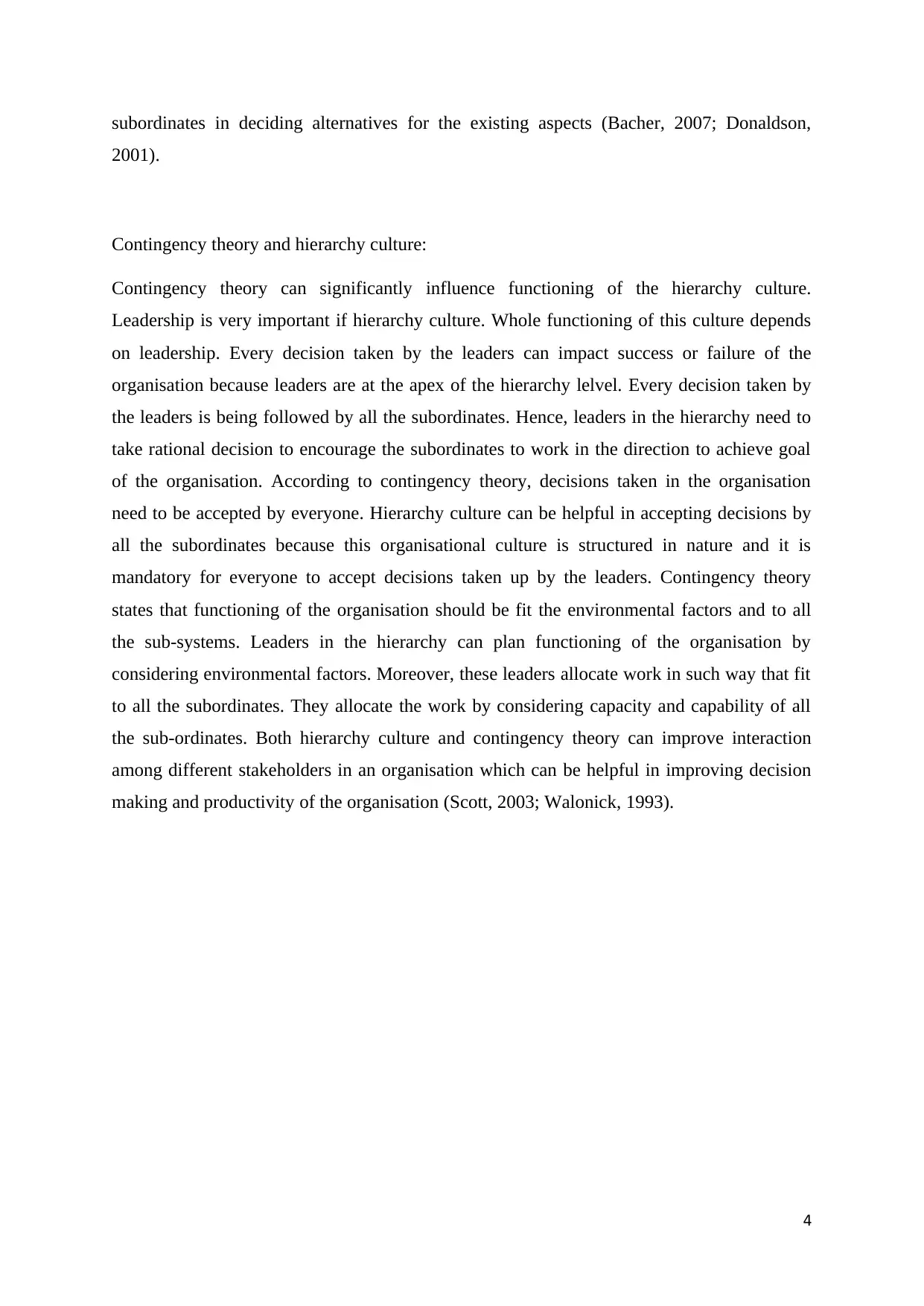Nursing Assignment: Leadership, Culture, and Organizational Theories
VerifiedAdded on 2021/06/16
|5
|1311
|88
Report
AI Summary
This report analyzes the hierarchy culture prevalent in nursing organizations, emphasizing its structured approach, formal procedures, and top-down leadership style. It explores the application of the mission hypothesis, highlighting how a sense of purpose and responsibility at each level contributes to organizational stability and goal achievement within this hierarchical framework. The report further examines the contingency theory, which posits that organizational effectiveness depends on adapting to both internal and external constraints, including leadership styles and decision-making processes. It underscores how these theories interact within a hierarchy culture, influencing factors such as decision-making, productivity, and the overall success of the organization. The analysis includes a discussion of how leadership decisions, environmental factors, and subsystem alignment impact the functionality and performance of the nursing organization.

Nursing Assignment
1
1
Paraphrase This Document
Need a fresh take? Get an instant paraphrase of this document with our AI Paraphraser

Hierarchy Culture:
Hierarchy Culture is being followed in the organisation. This culture is based on the structure
and control. Work environment is being followed is formal and all the institutional
procedures and process are in place which are acting as direction. Leadership in this
organisational culture perform its activities based on the coordination and monitoring which
is helpful in achieving efficiency and predictability. These leaders are proud of this type of
working culture. For leaders and other stakeholders in this organisational culture, it is very
important to keep functioning of this organisation very smoothly. Functioning of the
organisation is based on the formal rules and policies and it is helpful in keeping coordinated
work-culture in this organisation. Consistency and uniformity in the output are the main
values of this organisational culture. In this organisational culture, there is formalised and
structured work environment. In this organisational culture different people and tasks are
organised according to the level of efficiency and importance. Top-down approach is being
implemented to control and guide practices and activities. Power, status and position of the
leaders are helpful for the leaders to control their subordinates and their activities. Long term
goals of this organisational culture are stability, outcome, efficiency and well-organized
execution of tasks. Success of this organisation depends of factors like trustful delivery,
smooth planning, and low costs. Work culture in this organisational culture can predict
guaranteed execution and completion of work through personal management. Quality
improvement strategy in this type of organisation culture is based on error detection,
measurement, process control, systematic problem solving and quality tools (Diefenbach,
2016; Oliver, 2011).
Mission hypothesis :
Mission hypothesis is applicable to the hierarchy culture. Mission hypothesis states that there
should be sense of purpose for each individual in the organisation. This sense of purpose
mainly due to sense of responsibility given to each and every individual. Individual at each
level in this hierarchy is with assigned tasks based on their capacity and capability. All the
activities according to this mission should be based of particular direction and strategy. These
directions can be given by the people at the top level, hence top-down approach can be
effectively implemented through this mission. This top-down approach is the basic
fundamental of the hierarchy culture. It can be helpful in bringing improved coordination
among different members of the organisation and stimulate them to work towards achieving
2
Hierarchy Culture is being followed in the organisation. This culture is based on the structure
and control. Work environment is being followed is formal and all the institutional
procedures and process are in place which are acting as direction. Leadership in this
organisational culture perform its activities based on the coordination and monitoring which
is helpful in achieving efficiency and predictability. These leaders are proud of this type of
working culture. For leaders and other stakeholders in this organisational culture, it is very
important to keep functioning of this organisation very smoothly. Functioning of the
organisation is based on the formal rules and policies and it is helpful in keeping coordinated
work-culture in this organisation. Consistency and uniformity in the output are the main
values of this organisational culture. In this organisational culture, there is formalised and
structured work environment. In this organisational culture different people and tasks are
organised according to the level of efficiency and importance. Top-down approach is being
implemented to control and guide practices and activities. Power, status and position of the
leaders are helpful for the leaders to control their subordinates and their activities. Long term
goals of this organisational culture are stability, outcome, efficiency and well-organized
execution of tasks. Success of this organisation depends of factors like trustful delivery,
smooth planning, and low costs. Work culture in this organisational culture can predict
guaranteed execution and completion of work through personal management. Quality
improvement strategy in this type of organisation culture is based on error detection,
measurement, process control, systematic problem solving and quality tools (Diefenbach,
2016; Oliver, 2011).
Mission hypothesis :
Mission hypothesis is applicable to the hierarchy culture. Mission hypothesis states that there
should be sense of purpose for each individual in the organisation. This sense of purpose
mainly due to sense of responsibility given to each and every individual. Individual at each
level in this hierarchy is with assigned tasks based on their capacity and capability. All the
activities according to this mission should be based of particular direction and strategy. These
directions can be given by the people at the top level, hence top-down approach can be
effectively implemented through this mission. This top-down approach is the basic
fundamental of the hierarchy culture. It can be helpful in bringing improved coordination
among different members of the organisation and stimulate them to work towards achieving
2

collective goal for betterment of the organisation. This hypothesis can be helpful encouraging
and improving stability in the organisation. However, it doesn’t allow for change and
adaptability in the organisation. It can also be helpful in addressing association of the
organisation to the external organisation. This hypothesis cannot be helpful to focus on the
internal organisational dynamics because in this organisational culture all the positions and
activities are well structured and planned. Mission hypothesis is closely associated with the
effectiveness of organizational effectiveness perspectives. Stability and control can be
effectively aligned with internal focus and integration in hierarchy organisational culture
through this mission hypothesis. Mission hypothesis can effectively exhibit positive effect on
the performance indicator of the organisation (Baker, 2002; Cameron and Quinn, 2011;
Rahman, 2016).
Contingency theory :
Contingency theory presents organisation as constrained optimization problem. It gives
meaning that organisation can maximise their performance by reducing the influence of
environmental and internal constraints. This theory clearly mentioned, there is no particular
methodology to run any organisation. It can vary depends on the organisational aims,
objectives, people working in the organisation and organisational culture. Leadership and
decision making proved useful in one organisation can not be applicable in another
organisation. Different types of organisation structure and organisation cultures require
different types of leadership. Optimal functioning, leadership and decision making of an
organisation get influenced by various external and internal factors. These factors include
size of the organisation, adaptation ability of the organisation to the environment and
variability in resources and operational activities. Organisation need to identify these
constrains and work in the direction to eliminate these constraints. Organisational design and
its subsystems need to fit the organisational environment. Organisation need to have proper
fit not only with the environment but also among subsystems present in the organisation. In
contingency theory, success of leadership in an organisation depends on varied factors like
subordinate, activities or task and variables among group members. Success of the group in
the organisation depends on the interaction between leadership style and particulars of the
environment in which work is being carried out. According to contingency theory, decision
making depends on the importance of decision quality and acceptance, quantity and quality of
information handled by leader and subordinate and degree of disagreement among different
3
and improving stability in the organisation. However, it doesn’t allow for change and
adaptability in the organisation. It can also be helpful in addressing association of the
organisation to the external organisation. This hypothesis cannot be helpful to focus on the
internal organisational dynamics because in this organisational culture all the positions and
activities are well structured and planned. Mission hypothesis is closely associated with the
effectiveness of organizational effectiveness perspectives. Stability and control can be
effectively aligned with internal focus and integration in hierarchy organisational culture
through this mission hypothesis. Mission hypothesis can effectively exhibit positive effect on
the performance indicator of the organisation (Baker, 2002; Cameron and Quinn, 2011;
Rahman, 2016).
Contingency theory :
Contingency theory presents organisation as constrained optimization problem. It gives
meaning that organisation can maximise their performance by reducing the influence of
environmental and internal constraints. This theory clearly mentioned, there is no particular
methodology to run any organisation. It can vary depends on the organisational aims,
objectives, people working in the organisation and organisational culture. Leadership and
decision making proved useful in one organisation can not be applicable in another
organisation. Different types of organisation structure and organisation cultures require
different types of leadership. Optimal functioning, leadership and decision making of an
organisation get influenced by various external and internal factors. These factors include
size of the organisation, adaptation ability of the organisation to the environment and
variability in resources and operational activities. Organisation need to identify these
constrains and work in the direction to eliminate these constraints. Organisational design and
its subsystems need to fit the organisational environment. Organisation need to have proper
fit not only with the environment but also among subsystems present in the organisation. In
contingency theory, success of leadership in an organisation depends on varied factors like
subordinate, activities or task and variables among group members. Success of the group in
the organisation depends on the interaction between leadership style and particulars of the
environment in which work is being carried out. According to contingency theory, decision
making depends on the importance of decision quality and acceptance, quantity and quality of
information handled by leader and subordinate and degree of disagreement among different
3
⊘ This is a preview!⊘
Do you want full access?
Subscribe today to unlock all pages.

Trusted by 1+ million students worldwide

subordinates in deciding alternatives for the existing aspects (Bacher, 2007; Donaldson,
2001).
Contingency theory and hierarchy culture:
Contingency theory can significantly influence functioning of the hierarchy culture.
Leadership is very important if hierarchy culture. Whole functioning of this culture depends
on leadership. Every decision taken by the leaders can impact success or failure of the
organisation because leaders are at the apex of the hierarchy lelvel. Every decision taken by
the leaders is being followed by all the subordinates. Hence, leaders in the hierarchy need to
take rational decision to encourage the subordinates to work in the direction to achieve goal
of the organisation. According to contingency theory, decisions taken in the organisation
need to be accepted by everyone. Hierarchy culture can be helpful in accepting decisions by
all the subordinates because this organisational culture is structured in nature and it is
mandatory for everyone to accept decisions taken up by the leaders. Contingency theory
states that functioning of the organisation should be fit the environmental factors and to all
the sub-systems. Leaders in the hierarchy can plan functioning of the organisation by
considering environmental factors. Moreover, these leaders allocate work in such way that fit
to all the subordinates. They allocate the work by considering capacity and capability of all
the sub-ordinates. Both hierarchy culture and contingency theory can improve interaction
among different stakeholders in an organisation which can be helpful in improving decision
making and productivity of the organisation (Scott, 2003; Walonick, 1993).
4
2001).
Contingency theory and hierarchy culture:
Contingency theory can significantly influence functioning of the hierarchy culture.
Leadership is very important if hierarchy culture. Whole functioning of this culture depends
on leadership. Every decision taken by the leaders can impact success or failure of the
organisation because leaders are at the apex of the hierarchy lelvel. Every decision taken by
the leaders is being followed by all the subordinates. Hence, leaders in the hierarchy need to
take rational decision to encourage the subordinates to work in the direction to achieve goal
of the organisation. According to contingency theory, decisions taken in the organisation
need to be accepted by everyone. Hierarchy culture can be helpful in accepting decisions by
all the subordinates because this organisational culture is structured in nature and it is
mandatory for everyone to accept decisions taken up by the leaders. Contingency theory
states that functioning of the organisation should be fit the environmental factors and to all
the sub-systems. Leaders in the hierarchy can plan functioning of the organisation by
considering environmental factors. Moreover, these leaders allocate work in such way that fit
to all the subordinates. They allocate the work by considering capacity and capability of all
the sub-ordinates. Both hierarchy culture and contingency theory can improve interaction
among different stakeholders in an organisation which can be helpful in improving decision
making and productivity of the organisation (Scott, 2003; Walonick, 1993).
4
Paraphrase This Document
Need a fresh take? Get an instant paraphrase of this document with our AI Paraphraser

References:
Bacher, C. (2007). Contingency Theory. GRIN Verlag.
Baker, K. A. (2002) Organizational Culture [Online]. Retrieved from:
www.au.af.mil/au/awc/awcgate/doe/benchmark/ch11.pdf. On 27.04.2018.
Cameron, K. S., and Quinn, R. E. (2011). Diagnosing and Changing Organizational Culture:
Based on the Competing Values Framework. John Wiley & Sons.
Diefenbach, T. (2016). Hierarchy and Organisation: Toward a General Theory of
Hierarchical Social Systems. Routledge.
Donaldson, L. (2001). The Contingency Theory of Organizations. SAGE.
Oliver, G. (2011). Organisational Culture for Information Managers. Elsevier.
Rahman, M. M. (2016). Leadership. Analysis of Trait, Behaviour, and Contingency Theories.
GRIN Verlag.
Scott, T. (2003). Healthcare Performance and Organisational Culture. Radcliffe Publishing.
Walonick, D. S. (1993). Organizational Theory and Behavior. Retrieved from
http://www.statpac.org/walonick/organizational-theory.htm on 27.04.2018.
5
Bacher, C. (2007). Contingency Theory. GRIN Verlag.
Baker, K. A. (2002) Organizational Culture [Online]. Retrieved from:
www.au.af.mil/au/awc/awcgate/doe/benchmark/ch11.pdf. On 27.04.2018.
Cameron, K. S., and Quinn, R. E. (2011). Diagnosing and Changing Organizational Culture:
Based on the Competing Values Framework. John Wiley & Sons.
Diefenbach, T. (2016). Hierarchy and Organisation: Toward a General Theory of
Hierarchical Social Systems. Routledge.
Donaldson, L. (2001). The Contingency Theory of Organizations. SAGE.
Oliver, G. (2011). Organisational Culture for Information Managers. Elsevier.
Rahman, M. M. (2016). Leadership. Analysis of Trait, Behaviour, and Contingency Theories.
GRIN Verlag.
Scott, T. (2003). Healthcare Performance and Organisational Culture. Radcliffe Publishing.
Walonick, D. S. (1993). Organizational Theory and Behavior. Retrieved from
http://www.statpac.org/walonick/organizational-theory.htm on 27.04.2018.
5
1 out of 5
Related Documents
Your All-in-One AI-Powered Toolkit for Academic Success.
+13062052269
info@desklib.com
Available 24*7 on WhatsApp / Email
![[object Object]](/_next/static/media/star-bottom.7253800d.svg)
Unlock your academic potential
Copyright © 2020–2025 A2Z Services. All Rights Reserved. Developed and managed by ZUCOL.





